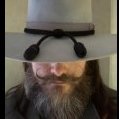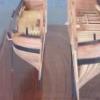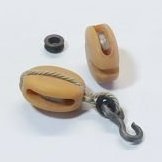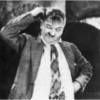Supplies of the Ship Modeler's Handbook are running out. Get your copy NOW before they are gone! Click on photo to order.
×

dcicero
-
Posts
266 -
Joined
-
Last visited
Reputation Activity
-
 dcicero got a reaction from fnkershner in 18th Century Longboat by dcicero - FINISHED - Model Shipways - 1:48 - Tri-Club
dcicero got a reaction from fnkershner in 18th Century Longboat by dcicero - FINISHED - Model Shipways - 1:48 - Tri-Club
Last week was full of distractions and I got very little done on the longboat ... but what I did get done looks pretty good.
The forward platform went in just fine.
Making the risers was also pretty straightforward. I didn't complicate the scribing of the grooves. I just ran an awl against the edge of a ruler and scribed them in. A couple of passes was all it took to get some good looking grooves in them. (I did have one riser look a little more "fuzzy" than the other one. Don't know why, but it'll all sand out.)
The amount of edge bending needed was a little more than I had initially anticipated. It took two trips to the glass plate to get enough bend in the plank to get it to sit correctly against the frames with a consistent measurement from the top of the cap rail.
When I went to install the risers, I found that the forward platform was a little too high. When it was just the template sitting there it looked fine, of course. That operation wasn't that tough. I just made it a little smaller and sanded the frames a little bit more.
Once the platform was back in, the risers went in without a problem.
Then it was time to put in the locker bulkhead. Following the instructions, I made a template. The nice thing about using templates is the ability to alter them quickly and easily. I started out tracing the frame from the plans and then gluing that outline to a piece of cardstock. I cut out the template and found it was far too large to fit in the space behind the frame, so I cut it down ... too much. That was no problem because I just added another layer of cardstock and added in what needed to be replaced. That worked great.
Then I cut a piece of basswood to size and fitted it in place.
Now on to making the thwarts!
Dan
-
 dcicero got a reaction from yvesvidal in 18th Century Longboat by dcicero - FINISHED - Model Shipways - 1:48 - Tri-Club
dcicero got a reaction from yvesvidal in 18th Century Longboat by dcicero - FINISHED - Model Shipways - 1:48 - Tri-Club
The aft platform is in ... and the forward one has been made and is ready for installation.
I saw The Lego Movie this weekend with the kids. (Don't laugh. It's really very good.) There's a lesson in the movie about following the instructions and how that's not always the best plan. Ignore that. Follow the instructions. Here's why.
Instead of following the instructions, which say to make the template then make up the blank for the platforms, I did the opposite. I looked at the photos, counted the number of planks I needed and made up the blank. Then, while the glue was drying, I made up a template to allow me to cut the blank to shape.
Bad plan because, in truing up the edges of the planks, I needed more planks to make a proper aft platform.
See? Not wide enough. I made another blank, wider this time, and everything worked out fine. I did make one, small alteration. When I glued the planks together, even though I let them set up under a weight, there was some bowing of the platform.
I put a small piece of planking material on the bottom of the platform, between the frames. That flattened it right out.
Here's the final result.
Dan
-
 dcicero got a reaction from firdajan in 18th Century Longboat by dcicero - FINISHED - Model Shipways - 1:48 - Tri-Club
dcicero got a reaction from firdajan in 18th Century Longboat by dcicero - FINISHED - Model Shipways - 1:48 - Tri-Club
The aft platform is in ... and the forward one has been made and is ready for installation.
I saw The Lego Movie this weekend with the kids. (Don't laugh. It's really very good.) There's a lesson in the movie about following the instructions and how that's not always the best plan. Ignore that. Follow the instructions. Here's why.
Instead of following the instructions, which say to make the template then make up the blank for the platforms, I did the opposite. I looked at the photos, counted the number of planks I needed and made up the blank. Then, while the glue was drying, I made up a template to allow me to cut the blank to shape.
Bad plan because, in truing up the edges of the planks, I needed more planks to make a proper aft platform.
See? Not wide enough. I made another blank, wider this time, and everything worked out fine. I did make one, small alteration. When I glued the planks together, even though I let them set up under a weight, there was some bowing of the platform.
I put a small piece of planking material on the bottom of the platform, between the frames. That flattened it right out.
Here's the final result.
Dan
-
 dcicero got a reaction from fnkershner in 18th Century Longboat by dcicero - FINISHED - Model Shipways - 1:48 - Tri-Club
dcicero got a reaction from fnkershner in 18th Century Longboat by dcicero - FINISHED - Model Shipways - 1:48 - Tri-Club
The aft platform is in ... and the forward one has been made and is ready for installation.
I saw The Lego Movie this weekend with the kids. (Don't laugh. It's really very good.) There's a lesson in the movie about following the instructions and how that's not always the best plan. Ignore that. Follow the instructions. Here's why.
Instead of following the instructions, which say to make the template then make up the blank for the platforms, I did the opposite. I looked at the photos, counted the number of planks I needed and made up the blank. Then, while the glue was drying, I made up a template to allow me to cut the blank to shape.
Bad plan because, in truing up the edges of the planks, I needed more planks to make a proper aft platform.
See? Not wide enough. I made another blank, wider this time, and everything worked out fine. I did make one, small alteration. When I glued the planks together, even though I let them set up under a weight, there was some bowing of the platform.
I put a small piece of planking material on the bottom of the platform, between the frames. That flattened it right out.
Here's the final result.
Dan
-
 dcicero got a reaction from tlevine in 18th Century Longboat by dcicero - FINISHED - Model Shipways - 1:48 - Tri-Club
dcicero got a reaction from tlevine in 18th Century Longboat by dcicero - FINISHED - Model Shipways - 1:48 - Tri-Club
The aft platform is in ... and the forward one has been made and is ready for installation.
I saw The Lego Movie this weekend with the kids. (Don't laugh. It's really very good.) There's a lesson in the movie about following the instructions and how that's not always the best plan. Ignore that. Follow the instructions. Here's why.
Instead of following the instructions, which say to make the template then make up the blank for the platforms, I did the opposite. I looked at the photos, counted the number of planks I needed and made up the blank. Then, while the glue was drying, I made up a template to allow me to cut the blank to shape.
Bad plan because, in truing up the edges of the planks, I needed more planks to make a proper aft platform.
See? Not wide enough. I made another blank, wider this time, and everything worked out fine. I did make one, small alteration. When I glued the planks together, even though I let them set up under a weight, there was some bowing of the platform.
I put a small piece of planking material on the bottom of the platform, between the frames. That flattened it right out.
Here's the final result.
Dan
-
 dcicero got a reaction from BRiddoch in 18th Century Longboat by dcicero - FINISHED - Model Shipways - 1:48 - Tri-Club
dcicero got a reaction from BRiddoch in 18th Century Longboat by dcicero - FINISHED - Model Shipways - 1:48 - Tri-Club
The aft platform is in ... and the forward one has been made and is ready for installation.
I saw The Lego Movie this weekend with the kids. (Don't laugh. It's really very good.) There's a lesson in the movie about following the instructions and how that's not always the best plan. Ignore that. Follow the instructions. Here's why.
Instead of following the instructions, which say to make the template then make up the blank for the platforms, I did the opposite. I looked at the photos, counted the number of planks I needed and made up the blank. Then, while the glue was drying, I made up a template to allow me to cut the blank to shape.
Bad plan because, in truing up the edges of the planks, I needed more planks to make a proper aft platform.
See? Not wide enough. I made another blank, wider this time, and everything worked out fine. I did make one, small alteration. When I glued the planks together, even though I let them set up under a weight, there was some bowing of the platform.
I put a small piece of planking material on the bottom of the platform, between the frames. That flattened it right out.
Here's the final result.
Dan
-
 dcicero reacted to Keith_W in Bounty Launch by KeithW - FINISHED - Model Shipways - SMALL - kitbashed
dcicero reacted to Keith_W in Bounty Launch by KeithW - FINISHED - Model Shipways - SMALL - kitbashed
Thanks for all the comments and likes, everyone!
Anyway, I did some work on the carpenter's chest. I modelled it in the open position. I took inspiration from Cap'n Rat Fink's chest here: http://modelshipworld.com/index.php?/topic/849-hms-bounty-launch-by-teleman-116-bashed-completed/?p=12090 (copied the hollow lid idea), as well as Meredith's hinges here: http://modelshipworld.com/index.php?/topic/2160-hms-bounty-launch-by-meredith-modelshipways/?p=143922
At the time I was wondering whether I could make metalwork as fine as hers, but as it turns out ... I can't. Try as I might, I am not able to make two "F" shapes in the supplied brass strip, so I made an "I" and a "C" instead. Still, I think the result looks OK.
Here are some pictures for your viewing pleasure or amusement. Probably the latter
-
 dcicero reacted to DanPage in HMAV Bounty by DanPage - FINISHED - Caldercraft - Scale 1:64
dcicero reacted to DanPage in HMAV Bounty by DanPage - FINISHED - Caldercraft - Scale 1:64
Hi
Thanks for your comments Peter. I'm afraid I don't put any of my mopdels in a glass case, I don't think there would be enough room in the house. As it is 'er indoors' is not too happy and I have to rotate some via my workshop (shed!).
As I said in my last post I will now present a few photographs showing more details with the final shot showing the model in its final resting place in the lounge.
Danny
-
 dcicero got a reaction from Ryland Craze in 18th Century Longboat by dcicero - FINISHED - Model Shipways - 1:48 - Tri-Club
dcicero got a reaction from Ryland Craze in 18th Century Longboat by dcicero - FINISHED - Model Shipways - 1:48 - Tri-Club
Well, I got the floor boards in.
I followed the plans closely on this and tapered the boards. The center board is tapered toward the bow. The boards just outboard of the center board are tapered on one side only, toward the bow. The outboard ones are tapered fore and aft on one side.
Here's what they looked like before they were installed.
Getting them lined up was easy. I used some excess planking material as spacers and some small blocks and rubber bands to hold them in place while the glue set up.
And here's the finished product.
Next came the aft platform. Again, this was pretty simple.
Cut some planks to length...
Use a pencil to mark one side of the planks to simulate cauking and glue them together. I used my glass plate again to keep everything flat.
And here's the final result.
This is the blank. I need to cut it to shape. I was going to do that yesterday, but got waylaid by the flu. No building got done yesterday. My intent was to bring the plans into work and make a couple of copies so I could cut out a template ... and then I forgot to bring the plans in. Doh! Maybe I'll get to that tonight...
Dan
-
 dcicero got a reaction from JesseLee in Scottish Maid by JesseLee - FINISHED - Artesania Latina - 1:50
dcicero got a reaction from JesseLee in Scottish Maid by JesseLee - FINISHED - Artesania Latina - 1:50
Great job, Jesse!
The waterways and bulwarks are a pain to install on this model. I ended up scrapping the ones in the kit and making my own because I couldn't get the kit-supplied ones to line up properly.
And the "instructions?" Ha! They could have just left them out of the kit.
That said, it does build into a very nice model.
Here's mine.
Dan
-
 dcicero reacted to Keith_W in Bounty Launch by KeithW - FINISHED - Model Shipways - SMALL - kitbashed
dcicero reacted to Keith_W in Bounty Launch by KeithW - FINISHED - Model Shipways - SMALL - kitbashed
I'm back from my trip, so I have continued some work with this boat. Over the weekend, I completed the standing rigging.
I have seized shrouds many times in the past, but I have never been satisfied with the results. This is the theory:
So how do you do that in miniature scale on a ship model? The answer is to use crocodile clips, like this:
If you can't see what's happening, I have created a series of diagrams that show how the seizing is accomplished. The text and pictures are self-explanatory.
This is the result:
I also added an eye bolt for the mainmast stay. Mackay's plans indicate that this was present, but did not indicate where it was attached - so I took a guess.
The boat as of tonight:
Next I should tackle the spars and sails, but I am thinking of buying a cheap sewing machine to help me make the sails. The sails are therefore on hold until I do a bit of research and learn how to sew on spare cloth. Neither can I attempt making the oars, because I want to reserve that for when my new lathe arrives. I suppose i'll just make the toolbox and a few other little accessories while I wait.
It also appears that I have run out of rigging thread. Let's hope that my local hobby shop stocks the same thread used by Model Shipways.
-
 dcicero got a reaction from CaptainSteve in Bounty Launch by KeithW - FINISHED - Model Shipways - SMALL - kitbashed
dcicero got a reaction from CaptainSteve in Bounty Launch by KeithW - FINISHED - Model Shipways - SMALL - kitbashed
Your Bounty Launch is really making me want to build one myself. You're doing a tremendous job on this model.
Dan
-
 dcicero got a reaction from mtaylor in 18th Century Longboat by dcicero - FINISHED - Model Shipways - 1:48 - Tri-Club
dcicero got a reaction from mtaylor in 18th Century Longboat by dcicero - FINISHED - Model Shipways - 1:48 - Tri-Club
Thanks, Toni. I puttered around with the model last night and made the decision to stop puttering around with the waterline. It looks better than it did and, like you say, if I keep raising it, I'm going to have a problem with the rudder.
Thanks, too, for the compliment on The Fife Rail. Our meetings start at 7:30 PM, which is about Francesco's bedtime. He toughed it out as long as he could, but eventually...
Both he and Nicolas had a good time, but it was a late night for them. They were both asleep in the backseat before we were out of Westmont.
Dan
-
 dcicero got a reaction from dgbot in 18th Century Longboat by dcicero - FINISHED - Model Shipways - 1:48 - Tri-Club
dcicero got a reaction from dgbot in 18th Century Longboat by dcicero - FINISHED - Model Shipways - 1:48 - Tri-Club
Thanks, Toni. I puttered around with the model last night and made the decision to stop puttering around with the waterline. It looks better than it did and, like you say, if I keep raising it, I'm going to have a problem with the rudder.
Thanks, too, for the compliment on The Fife Rail. Our meetings start at 7:30 PM, which is about Francesco's bedtime. He toughed it out as long as he could, but eventually...
Both he and Nicolas had a good time, but it was a late night for them. They were both asleep in the backseat before we were out of Westmont.
Dan
-
 dcicero got a reaction from Chuck in 18th Century Longboat by dcicero - FINISHED - Model Shipways - 1:48 - Tri-Club
dcicero got a reaction from Chuck in 18th Century Longboat by dcicero - FINISHED - Model Shipways - 1:48 - Tri-Club
Thanks, Toni. I puttered around with the model last night and made the decision to stop puttering around with the waterline. It looks better than it did and, like you say, if I keep raising it, I'm going to have a problem with the rudder.
Thanks, too, for the compliment on The Fife Rail. Our meetings start at 7:30 PM, which is about Francesco's bedtime. He toughed it out as long as he could, but eventually...
Both he and Nicolas had a good time, but it was a late night for them. They were both asleep in the backseat before we were out of Westmont.
Dan
-
 dcicero got a reaction from aykutansin in 18th Century Longboat by dcicero - FINISHED - Model Shipways - 1:48 - Tri-Club
dcicero got a reaction from aykutansin in 18th Century Longboat by dcicero - FINISHED - Model Shipways - 1:48 - Tri-Club
Fitting the false keel required some sand-fit-sand-fit too. I really made an effort to get the two pieces to fit together without forcing them. I figured the last thing that little joint needed was a torque that was going to force it apart. In the end, it worked out really well and was glued together using the glass plate again.
-
 dcicero got a reaction from dgbot in 18th Century Longboat by dcicero - FINISHED - Model Shipways - 1:48 - Tri-Club
dcicero got a reaction from dgbot in 18th Century Longboat by dcicero - FINISHED - Model Shipways - 1:48 - Tri-Club
I've been putting it off: painting the bottom of the boat. There are reasons for this. First, getting the waterline on straight has been weighing heavily on my mind. How should I do that? Second, masking the area off and not getting paint under the tape or ripping the paint off removing the tape or God only knows what else could go wrong... Third, I need to airbrush that paint on, but I've never used my airbrush before. I could spend time learning how to use the airbrush, but I really want to move forward on the Longboat. The result of all this: paralysis.
Last night, I hoisted myself off my half-moons and started. I strapped the model to the building board with rubber bands and leveled it out on the kitchen counter.
Then I constructed a High Speed, Low Drag Waterline Marketing Gauge using the Legos that the kids have strewn all over my house.
I drew on the waterline and then used Tamiya 6 mm masking tape to tape off the waterline. Only concern I had was where the tape buckled on the inside of the curve around the bow. I used a bone folder -- a piece of polished bone used to make very precise creases in book binding materials -- to burnish the tape down.
Tonight -- assuming I get the time to do it -- I'm going to putter around with the airbrush. I have the Model Master Acryl paint. (Heretical, I know.) I got some Model Master Acryl thinner so I can clean the airbrush. (I think I can spray that stuff without thinning it. I'll see how that goes.
If all goes well, I'll get the bottom of the boat painted this weekend and move along to the next stage.
One of these days, I'm going to be able to see around corners. That's my issue right now. Almost everything I'm doing, I'm doing for the first time, which means I have to learn how to do it, mess it up a couple of times and re-do it. That stretches out the timeline. It's fun -- don't get me wrong -- but frustrating at the same time because I'd like to be making more progress more quickly without sacrificing quality. It reminds me of a line from Chaucer: "The lyf so short, the craft so longe to lerne."
Dan
-
 dcicero got a reaction from fnkershner in 18th Century Longboat by dcicero - FINISHED - Model Shipways - 1:48 - Tri-Club
dcicero got a reaction from fnkershner in 18th Century Longboat by dcicero - FINISHED - Model Shipways - 1:48 - Tri-Club
There's a company here in the US that makes posters with demotivating statements on them, a kind of antidote to all those motivational posters one finds in many offices. This one's my favorite:
This is the story of my modeling life... My work serves as a warning to others.
Following Chuck's earlier advice, I sanded the caprail down more, as far as I thought I could go without doing more harm than good to the model. They're as narrow as I can make them now.
After attaching the friezes and then adding the rail below them, I noticed some inconsistency along the length of the boat. Here's a photo of the port side from the most unflattering angle.
I wrote an email to BobF and asked his advice. He told me that, if I'd been using white glue, I should be able to loosen it up with water and adjust the rail. I had used white glue, but I was still a little concerned that I would mess up the frieze by messing around with water. Not to worry, though. Using a small amount of water and a little piece of boxwood I had around, I cajoled the rail back into true. When the glue dried again, it was in the right place.
Reading Chuck's instructions again and looking at some of the other logs here, I became convinced that I'd done the stern frieze incorrectly. According to the instructions, the white stripe around the frieze should be 1/32" wide. Mine was more like 3/32", so I decided to re-do that too. I cut out a larger frieze, with the white part. I sanded the old one off. This would be the third time around for that stern freize. The first I removed by wetting it, which caused the transom to swell and threatened to loosen the planks surrounding it. Sanding it off got around that problem.
Note, I also put the stern block in place and trimmed the false keel down to the right length.
I wanted to add the extra plank shown in the NMM photos and which Bob had installed on his model. Bob helped me out with dimensions for those planks and I carefully made up a couple. I cut them down to a width of 3/32" first and then sanded them to 1/64" thickness, a time consuming project which, if done too fast, results in splintered planks. My advice: go slowly.
Here are those planks, installed. You can see the marked improvement in the rails below the friezes.
And here's the new stern frieze.
I did plank the hull from the bottom up and that resulted in an odd-looking run of planks at the sheer. The friezes and the extra plank go a long way toward correcting that odd appearance. The run of planks looks much better now, I think, and the extra plank is more consistent with the prototype. Straightening out that rail makes a world of difference and I think the stern frieze looks quite a lot better now too. (There's still some trimming needed on that frieze. That'll be done tomorrow.) Then it's off to the paint shop for the boat!
Dan
-
 dcicero got a reaction from BobF in 18th Century Longboat by dcicero - FINISHED - Model Shipways - 1:48 - Tri-Club
dcicero got a reaction from BobF in 18th Century Longboat by dcicero - FINISHED - Model Shipways - 1:48 - Tri-Club
I've been putting it off: painting the bottom of the boat. There are reasons for this. First, getting the waterline on straight has been weighing heavily on my mind. How should I do that? Second, masking the area off and not getting paint under the tape or ripping the paint off removing the tape or God only knows what else could go wrong... Third, I need to airbrush that paint on, but I've never used my airbrush before. I could spend time learning how to use the airbrush, but I really want to move forward on the Longboat. The result of all this: paralysis.
Last night, I hoisted myself off my half-moons and started. I strapped the model to the building board with rubber bands and leveled it out on the kitchen counter.
Then I constructed a High Speed, Low Drag Waterline Marketing Gauge using the Legos that the kids have strewn all over my house.
I drew on the waterline and then used Tamiya 6 mm masking tape to tape off the waterline. Only concern I had was where the tape buckled on the inside of the curve around the bow. I used a bone folder -- a piece of polished bone used to make very precise creases in book binding materials -- to burnish the tape down.
Tonight -- assuming I get the time to do it -- I'm going to putter around with the airbrush. I have the Model Master Acryl paint. (Heretical, I know.) I got some Model Master Acryl thinner so I can clean the airbrush. (I think I can spray that stuff without thinning it. I'll see how that goes.
If all goes well, I'll get the bottom of the boat painted this weekend and move along to the next stage.
One of these days, I'm going to be able to see around corners. That's my issue right now. Almost everything I'm doing, I'm doing for the first time, which means I have to learn how to do it, mess it up a couple of times and re-do it. That stretches out the timeline. It's fun -- don't get me wrong -- but frustrating at the same time because I'd like to be making more progress more quickly without sacrificing quality. It reminds me of a line from Chaucer: "The lyf so short, the craft so longe to lerne."
Dan
-
 dcicero got a reaction from mtaylor in 18th Century Longboat by dcicero - FINISHED - Model Shipways - 1:48 - Tri-Club
dcicero got a reaction from mtaylor in 18th Century Longboat by dcicero - FINISHED - Model Shipways - 1:48 - Tri-Club
I've been putting it off: painting the bottom of the boat. There are reasons for this. First, getting the waterline on straight has been weighing heavily on my mind. How should I do that? Second, masking the area off and not getting paint under the tape or ripping the paint off removing the tape or God only knows what else could go wrong... Third, I need to airbrush that paint on, but I've never used my airbrush before. I could spend time learning how to use the airbrush, but I really want to move forward on the Longboat. The result of all this: paralysis.
Last night, I hoisted myself off my half-moons and started. I strapped the model to the building board with rubber bands and leveled it out on the kitchen counter.
Then I constructed a High Speed, Low Drag Waterline Marketing Gauge using the Legos that the kids have strewn all over my house.
I drew on the waterline and then used Tamiya 6 mm masking tape to tape off the waterline. Only concern I had was where the tape buckled on the inside of the curve around the bow. I used a bone folder -- a piece of polished bone used to make very precise creases in book binding materials -- to burnish the tape down.
Tonight -- assuming I get the time to do it -- I'm going to putter around with the airbrush. I have the Model Master Acryl paint. (Heretical, I know.) I got some Model Master Acryl thinner so I can clean the airbrush. (I think I can spray that stuff without thinning it. I'll see how that goes.
If all goes well, I'll get the bottom of the boat painted this weekend and move along to the next stage.
One of these days, I'm going to be able to see around corners. That's my issue right now. Almost everything I'm doing, I'm doing for the first time, which means I have to learn how to do it, mess it up a couple of times and re-do it. That stretches out the timeline. It's fun -- don't get me wrong -- but frustrating at the same time because I'd like to be making more progress more quickly without sacrificing quality. It reminds me of a line from Chaucer: "The lyf so short, the craft so longe to lerne."
Dan
-
 dcicero got a reaction from Paddy in 18th Century Longboat by dcicero - FINISHED - Model Shipways - 1:48 - Tri-Club
dcicero got a reaction from Paddy in 18th Century Longboat by dcicero - FINISHED - Model Shipways - 1:48 - Tri-Club
I've been putting it off: painting the bottom of the boat. There are reasons for this. First, getting the waterline on straight has been weighing heavily on my mind. How should I do that? Second, masking the area off and not getting paint under the tape or ripping the paint off removing the tape or God only knows what else could go wrong... Third, I need to airbrush that paint on, but I've never used my airbrush before. I could spend time learning how to use the airbrush, but I really want to move forward on the Longboat. The result of all this: paralysis.
Last night, I hoisted myself off my half-moons and started. I strapped the model to the building board with rubber bands and leveled it out on the kitchen counter.
Then I constructed a High Speed, Low Drag Waterline Marketing Gauge using the Legos that the kids have strewn all over my house.
I drew on the waterline and then used Tamiya 6 mm masking tape to tape off the waterline. Only concern I had was where the tape buckled on the inside of the curve around the bow. I used a bone folder -- a piece of polished bone used to make very precise creases in book binding materials -- to burnish the tape down.
Tonight -- assuming I get the time to do it -- I'm going to putter around with the airbrush. I have the Model Master Acryl paint. (Heretical, I know.) I got some Model Master Acryl thinner so I can clean the airbrush. (I think I can spray that stuff without thinning it. I'll see how that goes.
If all goes well, I'll get the bottom of the boat painted this weekend and move along to the next stage.
One of these days, I'm going to be able to see around corners. That's my issue right now. Almost everything I'm doing, I'm doing for the first time, which means I have to learn how to do it, mess it up a couple of times and re-do it. That stretches out the timeline. It's fun -- don't get me wrong -- but frustrating at the same time because I'd like to be making more progress more quickly without sacrificing quality. It reminds me of a line from Chaucer: "The lyf so short, the craft so longe to lerne."
Dan
-
 dcicero got a reaction from flying_dutchman2 in 18th Century Longboat by dcicero - FINISHED - Model Shipways - 1:48 - Tri-Club
dcicero got a reaction from flying_dutchman2 in 18th Century Longboat by dcicero - FINISHED - Model Shipways - 1:48 - Tri-Club
There's a company here in the US that makes posters with demotivating statements on them, a kind of antidote to all those motivational posters one finds in many offices. This one's my favorite:
This is the story of my modeling life... My work serves as a warning to others.
Following Chuck's earlier advice, I sanded the caprail down more, as far as I thought I could go without doing more harm than good to the model. They're as narrow as I can make them now.
After attaching the friezes and then adding the rail below them, I noticed some inconsistency along the length of the boat. Here's a photo of the port side from the most unflattering angle.
I wrote an email to BobF and asked his advice. He told me that, if I'd been using white glue, I should be able to loosen it up with water and adjust the rail. I had used white glue, but I was still a little concerned that I would mess up the frieze by messing around with water. Not to worry, though. Using a small amount of water and a little piece of boxwood I had around, I cajoled the rail back into true. When the glue dried again, it was in the right place.
Reading Chuck's instructions again and looking at some of the other logs here, I became convinced that I'd done the stern frieze incorrectly. According to the instructions, the white stripe around the frieze should be 1/32" wide. Mine was more like 3/32", so I decided to re-do that too. I cut out a larger frieze, with the white part. I sanded the old one off. This would be the third time around for that stern freize. The first I removed by wetting it, which caused the transom to swell and threatened to loosen the planks surrounding it. Sanding it off got around that problem.
Note, I also put the stern block in place and trimmed the false keel down to the right length.
I wanted to add the extra plank shown in the NMM photos and which Bob had installed on his model. Bob helped me out with dimensions for those planks and I carefully made up a couple. I cut them down to a width of 3/32" first and then sanded them to 1/64" thickness, a time consuming project which, if done too fast, results in splintered planks. My advice: go slowly.
Here are those planks, installed. You can see the marked improvement in the rails below the friezes.
And here's the new stern frieze.
I did plank the hull from the bottom up and that resulted in an odd-looking run of planks at the sheer. The friezes and the extra plank go a long way toward correcting that odd appearance. The run of planks looks much better now, I think, and the extra plank is more consistent with the prototype. Straightening out that rail makes a world of difference and I think the stern frieze looks quite a lot better now too. (There's still some trimming needed on that frieze. That'll be done tomorrow.) Then it's off to the paint shop for the boat!
Dan
-
 dcicero got a reaction from flying_dutchman2 in 18th Century Longboat by dcicero - FINISHED - Model Shipways - 1:48 - Tri-Club
dcicero got a reaction from flying_dutchman2 in 18th Century Longboat by dcicero - FINISHED - Model Shipways - 1:48 - Tri-Club
A little more progess has been made ... and more questions raised.
I got the caprail installed and I think it looks great. Lots of sanding involved in this, but nothing difficult at all.
And then it was on to the friezes. I was dreading this step because it really looked like it was going to be a tough thing to pull off, but, in the end, it went very smoothly. I cut the friezes out and attached them with white glue.
The stern frieze was a little more difficult and here's where the question comes in. Looking at the other pictures here on the forum, it looked as if Chuck attached the colored part of the frieze and painted around it. It looks like Toni adhered the entire frieze, with the white part, and then cut around it. Looked to me like this was a judgement call ... so I made the call and adhered just the colored part of the frieze.
Did I make the right call?
Aligning the frieze, I found, was the most difficult part of the operation. What you see above is my second attempt ... in keeping with my practice of building everything at least twice. The glue dried so fast on the first attempt that I couldn't nudge it into place. I removed it, cut another frieze out and attached it as you see above.
Based on Bob's recommendations, I used a small amount of Elmer's White Carpenter's Wood Putty to fill in the small gaps at the bow. (You can see that filler in the pictures.) Now that I've made this call on the stern, I'm going to need a little bit of putty there too.
As for paints, I couldn't find a place that had the Badger paints, but after discussing what I was looking for with the guys at Al's Hobby Shop, I chose Model Master Acrylics. That's my next step!
Dan
-
 dcicero reacted to BRiddoch in 18th Century Longboat by Bob Riddoch - FINISHED
dcicero reacted to BRiddoch in 18th Century Longboat by Bob Riddoch - FINISHED
A few more pics.
Bob R.
-
 dcicero reacted to Keith_W in Bounty Launch by KeithW - FINISHED - Model Shipways - SMALL - kitbashed
dcicero reacted to Keith_W in Bounty Launch by KeithW - FINISHED - Model Shipways - SMALL - kitbashed
Finished early today. Rushed home, ripped my tie off, and within seconds was changed from an urban work drone and into my dingy modelling clothes
Today, I fabricated new thwarts for positions #1 and #4, and completed much work done yesterday.
This is the fore thwart (position #1). The reason why I need a new one is because I did not read the instructions properly! It says to position the foremast stay in relation to the fore thwart to achieve the correct rake. Well, I positioned my foremast stay according to the plans. When I came to test fit the fore thwart, the mast raked forwards!
As you can see, my new fore thwart is much wider than the one provided in the kit. It doesn't need to be that wide - in reality I probably need a couple of mm less. I will trim it when I come to fit the fore thwart so that it sits snug against the grating.
You should probably note that the thwart provided in the kit is too large for the mainmast - see the gaps around the dowel in the picture? The diameter of the fore thwart fits the mainmast perfectly though.
On the other hand, the thwart for the mainmast fits perfectly. This is pictured with my new #4 thwart.
And finally, here are some pictures of the boat as of right now. I painted on a blue stripe to match my Bounty. The planks look slightly shiny because they have just been given a coating of Tung Oil. I have to wait for the oil to cure before proceeding, so that's all for tonight.
Hmm, maybe I have time to start tapering the dowels for the masts ...
The instructions remind you that this is a working boat, and should not be finished "like a yacht". Well, it's MY boat, so i'll finish it like a yacht if I want to













